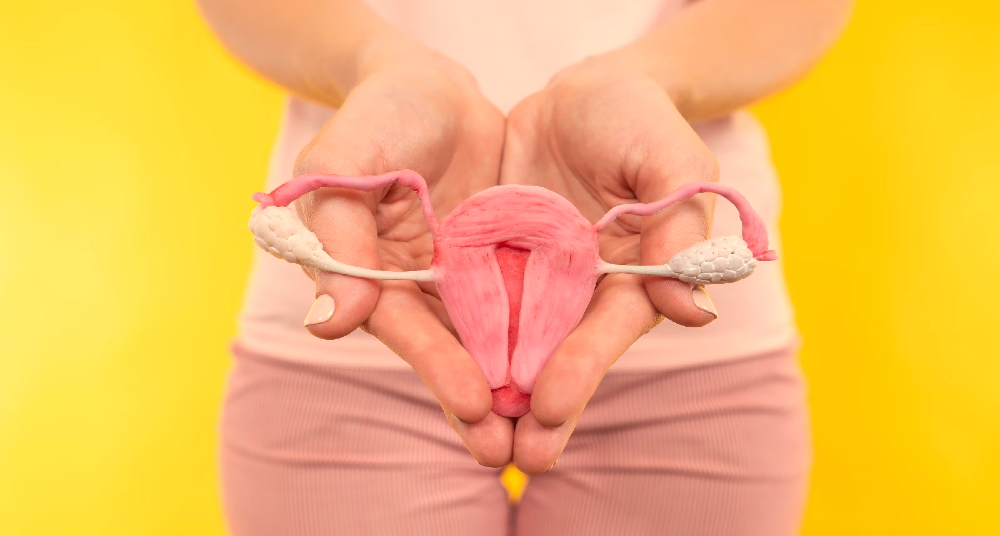Endometrioza je pogosto boleča motnja, pri kateri tkivo, podobno tkivu, ki običajno obdaja notranjost vaše maternice – endometriju – raste izven vaše maternice. Endometrioza najpogosteje vključuje jajčnike, jajcevode in tkivo, ki obdaja medenico.
ENDOMETRIOZA: Splošno o endometriozi | Vrste | Simptomi | Vzroki | Zdravljenje | Konvencionalna medicina | Alternativni načini | Prehrana | Domača zdravila | Preprečevanje | Dejavniki tveganja | Vprašanja in odgovori | Viri/reference
Endometrioza je kronična in pogosto boleča bolezen, ki prizadene ženske v rodni dobi. Zanjo je značilno, da se tkivo, podobno sluznici maternice, razvija izven maternice, kar lahko povzroči različne simptome, vključno s hudimi bolečinami med menstruacijo, bolečinami med spolnim odnosom ter težavami pri zanositvi. Kljub temu, da je endometrioza razmeroma pogosta, ostaja pogosto slabo razumljena in diagnosticirana.
Raziskave kažejo, da se lahko znaki endometrioze pojavijo že v adolescenci, vendar pa mnoge ženske ne prepoznajo svojih simptomov kot del te bolezni. Endometrioza lahko vpliva na kakovost življenja in psihološko dobrobit prizadetih žensk.
Popularen izbor:
 |
 |
 |
| Diverin krema | Nalgesin S | Zeolit |
Pomembno je, da se zavedamo različnih oblik endometrioze – od peritonealne do globoke infiltrativne – saj vsaka oblika prinaša svoje izzive in zahteva specifičen pristop k zdravljenju.
Slika: Endometrioza je vzrok za 30 do 40% neplodnosti žensk.

V tem članku bomo podrobneje obravnavali vzroke, simptome in možnosti zdravljenja endometrioze ter kako lahko prizadete ženske izboljšajo svoje zdravje in kakovost življenja.
Obstaja več vrst endometrioze:
- površinska endometrioza, ki se nahaja predvsem na peritoneju medenice
- cistična ovarijska endometrioza (endometriom), ki jo najdemo v jajčnikih
- globoka endometrioza v rekto-vaginalnem septumu, mehurju in črevesju
- v redkih primerih so endometriozo odkrili tudi zunaj medenice
V normalnih pogojih je tkivo, ki prekriva notranjost maternice in ga imenujemo endo-metrij, zgolj v maternici. Pri ženskah, ki trpijo zaradi endometrioze, pa se mikroskopsko majhni koščki tega tkiva preselijo tudi iz maternice, se vsadijo na druge organe in tkiva in se tam razraščajo.
Tovrstne okvare ali predeli nenormalnega tkiva so ponavadi v trebušni votlini - pogosto se razširijo po drugih predelih rodil, na primer jajčnikih ali po mišični steni maternice - v zelo redkih primerih pa lahko prizadenejo tudi druge organe, na primer pljuča.
Slika: Endometrioza najpogosteje vključuje jajčnike, jajcevode in tkivo, ki obdaja medenico.
.jpg)
Tako kot sam endometrij, se tudi presajeno tkivo odziva na hormona estrogen in progesteron. Vsak mesec se najprej zadebeli in nato krvavi. Ker pa je presajeno tkivo nameščeno v drugih tkivih, se kri, ki pri tem nastaja, ne more izliti in draži okolno tkivo, povzroča ciste, brazgotine in zarastline. Te lahko nazadnje zvežejo rodila skupaj, tako da se pod zdravnikovimi rokami premikajo kot ena sama velika gmota.
Primere endometrioze razvrščamo med minimalne, blage, zmerne in hude, odvisno od velikosti okvar in globine, do katere se je tkivo zarinilo v gostiteljski organ. Simptomi so lahko zelo različni in okoli 10% bolnic sploh nima nikakršnih simptomov. Druge pa imajo zelo obilne in boleče menstruacije in globoko bolečino v trebuhu med spolnim občevanjem.
Endometrioza je vzrok za 30 do 40% neplodnosti žensk. Pri ženskah, ki lahko zanosijo, se lahko simptomi med nosečnostjo zmanjšajo ali celo izginejo, vendar se čez leto ali dve spet povrnejo. Endometrioza najpogosteje prizadene ženske med tridesetim in štiridesetim letom starosti in ponavadi preneha ob menopavzi, ko tvorba estrogena močno upade.
Posebno tkivo, ki se imenuje endometrij, se med menstruacijo vsakič izloči iz maternice kot del naravnega procesa, če se koščki endometrijskega tkiva zasejejo v drugih organih v mali medenici, lahko tam rastejo, postanejo moteči in povzročajo bolečino ter nenormalno krvavitev. Če tega ne zdravimo, se tkivo razrašča in nazadnje ustvari ciste, ki motijo delovanje rodil.
Simptomi
Primarni simptom endometrioze je bolečina v medenici, ki je pogosto povezana z menstruacijo. Čeprav se mnoge ženske med menstruacijo soočajo s krči, tiste z endometriozo običajno opisujejo menstrualne bolečine, ki so veliko hujše od običajnih.
Video vsebina: 5 opozorilnih znakov endometrioze.

Pogosti znaki in simptomi vključujejo:
- ostre bolečine v trebuhu pred menstruacijo, med njo in takoj po njej
- ostra bolečina v trebuhu med spolnim občevanjem
- nenormalno obilne menstruacijske krvavitve, še zlasti, če nastaja veliko število strdkov in trajajo dlje kot sedem dni
- neplodnost
Posvetujte se z zdravnikom, če sumite, da imate endometriozo; pravilna diagnoza je bistvena za zdravljenje.
Vzroki
Raziskovalci ne vedo natančno, kako endometrijsko tkivo pride v druge dele telesa. Ena od možnosti je stanje, ki ga imenujemo retrogradna ali navzadajšnja menstruacija. Med menstruacijo se normalno deli odluščene maternične sluznice izločijo iz maternice skozi maternični vrat in nožnico.
Pri retrogradni menstruaciji pa delci endo-metrija splavajo nazaj v jajcevode, od koder lahko potem zaidejo tudi v trebušno votlino in povzročijo endometriozo. Dejansko so zdravniki opazili, da se endometrioza pojavlja pogosteje pri ženskah s tako telesno zgradbo, ki povečuje možnost retrogradne menstruacije. To so na primer ženske, ki imajo različne zapore v nožnici in materničnem vratu.
Slika: Endometrioza se pogosteje pojavlja pri ženskah, ki imajo različne zapore v nožnici in materničnem vratu.
.jpg)
O tem, ali tamponi pospešujejo retrogradni tok, je še vedno precej nesoglasij. Dokazi, kot kaže, to spodbijajo, vendar se nekatere ženske, ki imajo endometriozo, tamponom vendarle raje izogibajo.
V redkih primerih endometrioze, ki prizadene pljuča ali druga tkiva daleč od maternice, raziskovalci domnevajo, da zablodeli koščki endo-metrija pridejo do njih po krvnem obtoku ali po limfnem sistemu, čeprav nihče ne ve, kako naj bi se to pravzaprav zgodilo.
Druga teorija pa meni, da se endometrijsko tkivo premika zunaj maternice dokaj pogosto, vendar se endometrioza pojavi le pri ženskah, ki imajo težave z imunskim sistemom, kar preprečuje, da bi telo zablodele koščke uničilo.
Kljub nejasnosti glede specifičnih mehanizmov endometrioze pa lahko raziskovalci pokažejo na nekatere povezave. Dejstvo, da se bolezen pojavlja v določenih družinah, govori v prid možne vloge genetskih vplivov. Študije so tudi dokazale, da se endometrioza pogosteje pojavlja pri ženskah, ki imajo menstruacijski cikel krajši od normalnega, ali pri tistih, pri katerih cikel traja dlje kot normalno.
Ženske, pri katerih med eno in drugo menstruacijo mine manj kot 25 dni, ali tiste, pri katerih menstruacija traja dlje kot 7 dni, imajo dvakrat več možnosti za nastanek endometrioze. Nedavni dokazi pa govorijo, da je možen vzrok tudi izpostavljanje dioksinu, industrijski kemikaliji.
Video vsebina: Kaj je endometrioza?

Kot kaže ni med velikostjo okvar in stopnjo bolečine v mali medenici nobene prave povezave. Nekatere ženske, ki imajo manjše spremembe, tožijo za neznosnimi bolečinami, medtem ko nekatere ženske, ki imajo že zelo razširjeno okvaro, sploh nimajo nobenih simptomov. Bolečina verjetno izvira iz brazgotinjenja in vzdražljivosti, ki nastane zaradi krvavitev ali kadar endometrijsko tkivo zasede živec ali na njem zraste.
Prav tako ni povsem jasno, kako bolezen povzroča neplodnost, vendar ne kaže, da bi bila povezana s stopnjo endometrioze; neplodne so mnoge ženske z zelo drobnimi spremembami. Nekateri raziskovalci menijo, da endometrijski vložki zmotijo proces ovulacije. Vložki lahko tudi ovirajo prehod jajčeca skozi jajcevode, ker motijo čilije, ki bi morale jajčece premikati. Spet drugi raziskovalci pa pravijo, da vložki izločajo kemične snovi, ki ustvarjajo za oploditev neprijazno okolje.
Zdravljenje
Endometriozo lahko zdravimo na konvencionalni ali alternativni način, in sicer z vsem, od hormonskih tablet in kirugije do zeliščnih zdravil. Vendar pa s tem potek bolezni ukrotimo, same bolezni pa ne pozdravimo. Ko z zdravljenjem prenehamo, se simptomi pogosto povrnejo. Simptome ponavadi prekine menopavza, vendar pa se pri ženskah, ki jemljejo med menopavzo in po njej estrogene, simptomi nadaljujejo.
Slika: Zdravniki lahko diagnozo postavijo le z laparoskopijo.
.jpg)
Ker se endometrioza pogosto ponavlja in pogosto povzroča neplodnost, se boste morda priključili kateremu od društev za pomoč ženskam z endometriozo, o čemer vas morda lahko informirajo v bolnišnici.
Konvencionalna medicina
Zdravnik bo verjetno opravil ginekološki pregled in s tem poskusil izključiti druge možne vzroke vaših simptomov. Vendar pa lahko diagnozo postavijo le z laparoskopijo - pregledom, pri katerem uporabijo tanek instrument, opremljen s svetlobo, ki ga vstavijo skozi trebušno votlino skozi majhen rez. Postopek ponavadi opravijo v splošni anesteziji in mnogi zdravniki odvzamejo tudi košček za biopsijo, da potrdijo diagnozo.
Večina zdravnikov meni, da je za številne ženske, ki lahko zanosijo in bi rade imele otroka, nosečnost dober način zdravljenja. Nosečnost omili simptome, verjetno zato, ker začasno zaustavi menstruacijo. Pri nekaterih ženskah se endometrioza po porodu ne povrne. Druga možnost je, da zdravnik za devet mesecev ali dlje predpiše tablete proti zanositvi, s čimer se ustvari neke vrste lažna nosečnost, ki zaustavlja menstruacijske cikle in prekine krvavitve iz endo-metrijskih okvar. To zdravljenje je lahko učinkovito, vendar ni tako uspešno kot prava nosečnost.
Če po nenehnem jemanju tablet ni uspeha, zdravniki priporočajo zdravljenje z androgeni - moškimi hormoni. Zdravila, ki imajo hormonske učinke, kot sta na primer danazol in nafarelin, delujejo tako, da zaustavijo menstruacijski cikel in tako materničnemu tkivu onemogočijo, da bi krvavelo. Vendar ima danazol maskulinizirajoče stranske učinke, ki včasih po prenehanju jemanja ne izginejo; to so čezmerna poraščenost in - čeprav redko - nižji glas, zaradi česar ga ni mogoče jemati dlje časa.
Video vsebina: Naravna zdravila za endometriozo.

Dejansko je z vsemi temi načini zdravljenja popolna ozdravitev nemogoča, kajti vsadki ostanejo na organih in, ko se zdravljenje neha, začnejo spet redno mesečno krvaveti. Analgetiki, kot sta ibuprofen in naproksen, lahko ublažijo neugodje zaradi krčev, ne spremenijo pa cikličnih sprememb vsadkov. Torej tudi ti učinkujejo zgolj na simptome, ne zdravijo pa osnovnega vzroka.
Alternativni načini
Večina alternativnih zdravil je namenjenih lajšanju simptomov. Ker pa tako zdravljenje ne vpliva neposredno na okvaro, je pogosto manj učinkovito od konvencionalnega zdravljenja.
Joga
"Lok" poveča prožnost hrbtenice. Uležite se na trebuh in se primite za gležnja. Medtem, ko dihnete, stisnite zadnjico in počasi dvignite glavo, prsni koš in stegna od tal. Tako zdržite 15 sekund in pri tem počasi dihajte. Izdihnite in se sprostite. Vadite enkrat ali dvakrat dnevno.
Slika: Lok (joga pozicija).
.jpeg)
"Kobilica" veča tonus v mišicah male medenice. Uležite se na trebuh in položite roki ob telo. Stisnite zadnjico, medtem ko pritiskate z rokama ob tla. Med vdihom dvignite nogi in ju držite zravnani ter pritiskajte s prsti in petami navzven. Zdržite tako 15 sekund, nato izdihnite in se sprostite. Vajo delajte enkrat ali dvakrat dnevno.
Slika: Kobilica (joga pozicija).

"Čoln" okrepi hrbtenico in krepi področje v mali medenici. Medtem ko ležite na trebuhu, vdihnite in dvignite glavo, prsni koš, roki in nogi od tal. Roki stegnite za sabo in ostanite v takem položaju 15 do 20 sekund, nato izdihnite in se spet sprostite. Izvajajte čoln enkrat ali dvakrat dnevno.
Slika: Čoln (joga pozicija).

Joga ponuja več zdravilnih koristi, ki lahko pomagajo zmanjšati simptome endometrioze, kot so stres, napetost in bolečina. Spodbuja sprostitev, kar pomaga pri lajšanju nelagodja in umiri vaš um. Joga in dihalne tehnike so lahko koristne za lajšanje medeničnih bolečin pri ženskah z endometriozo.
Operacija
Kadar je rast tkiva razbohotena in je zdravljenje z zdravili neučinkovito, bo zdravnik morda svetoval operacijo. Če bodo z njo odstranili vse presajeno tkivo, bodo vaši simptomi izginili. Vendar pa lahko nekaj koščkov tkiva ostane in začnejo spet rasti in povzročati simptome, celo po popolni odstranitvi maternice (histerektomiji). Zdravnik se bo morda zato odločil za kombinacijo operacije in stalnega zdravljenja z zdravili.
Akupresura
Krče lahko omilite s pritiskanjem na točko Vranica 6, ki je na notranji strani nog, 5 cm nad gležnjem. Nosečnice tega načina ne smejo uporabljati.
Zelišča
Nekatere zeliščne formule lahko umirijo bolečino. Čeladnica (Scutellaria lateriflora), črni kohoš (Cimicifuga racemosa) in divji jam (Dioscorea villosa) lahko učinkujejo na osnovne hormonske težave. Baldrijan (Valeriana officinalis) lahko prispeva k sprostitvi, vendar ga ne smete jemati dlje kot en mesec.
Slika: Za zelišča so značilne visoke ravni bioaktivnih spojin.

Življenjski koren (Senecio aureus) in črni kohoš krepita zdravje organov v mali medenici. O posebnih zeliščnih formulah se posvetujte z zeliščarjem.
Prehrana
Za pomoč pri ustvarjanju ravnotežja med estrogeni in prostaglandini ter za zmanjšanje menstruacijskih krčev lahko jemljete dnevni dodatek multivitaminov in multimineralov, ki naj vsebuje:
- vitamine skupine B (50 do 100 mg),
- vitamin E (400 do 600 IE),
- kalcij (1000 mg) in
- magnezij (400 do 600 mg).
Telo vsebuje hormonom podobne snovi, ki jih imenujemo prostaglandini. Ti, poleg drugega, igrajo pomembno vlogo pri krčenju mišic in torej prispevajo k menstruacijskim krčem. Če jeste hrano, bogato z naravnimi antiprostaglandini - vključno s skušami, sardinami, lososom in tunino, se vam bodo morda simptomi omilili. Lahko pa se odločite, da namesto hranjenja s temi ribami jemljete dodatke ribjega olja.
Domača zdravila
Za sprostitev in omilitev krčev si poleg jemanja analgetikov za olajšanje bolečin na trebuh položite termofor ali vlažno toploto ter pijte tople napitke. Zmerno se razgibavajte, da dvignete endorfine, naravne telesne snovi proti bolečini. Za zmanjšanje napetosti pijte pomirjevalne zeliščne čaje iz zelišč, kot sta hmelj in baldrijan.
Slika: Za zmanjšanje napetosti pijte pomirjevalne zeliščne čaje iz zelišč.
.jpg)
Čaj je lahko obetavna alternativa zdravilom brez recepta za pomoč pri obvladovanju menstrualnih krčev. Pitje kamiličnega, komarčkovega ali ingverjevega čaja je preprost in naraven način za lajšanje teh bolečin.
Preprečevanje
Izogibajte se izpostavljanju dioksinu, za katerega obstajajo nedavni dokazi, da lahko v nekaterih primerih povzroča endometriozo. Kadar uporabljate tampone, jih pogosto menjujte, zlasti če močno krvavite, in poskusite tampone občasno zamenjavati z vložki oziroma s predlogami. S takim ravnanjem preprečite, da bi lahko menstruacijska kri tekla nazaj, kar je po eni izmed teorij vzrok za endometriozo.
Dejavniki tveganja
S povečanim tveganjem za endometriozo je povezanih več dejavnikov. Zavedajte se večje možnosti, da dobite endometriozo, če:
- imate bližnjo sorodnico z endometriozo, še zlasti, če je to vaša mati ali sestra
- imate redno kratek menstruacijski cikel - krajši od 25 dni
- med menstraucijo dolgo časa krvavite - dlje kot en teden
- med menstruacijami obilno krvavite
- uporabljate tampone in jih zamenjujete redkeje kot na osem ur
- uporabljate znotrajmaternični vložek
- imate zdravstveno težavo, ki zapira ali ovira dostop v maternično ustje ali nožnico
- imate prirojeno nepravilnost maternice, kot je dvoroga maternica ali dvojni maternični vrat
- ste bili izpostavljeni dioksinu
Zavedanje o endometriozi in njenih simptomih je ključno za pravočasno diagnozo in zdravljenje. Ženske, ki se spopadajo s simptomi, naj ne oklevajo poiskati zdravniško pomoč. S pravilnim pristopom in podporo je mogoče obvladovati to stanje ter izboljšati kakovost življenja.
Vprašanja in odgovori
Kako pogosta je endometrioza?
Endometrioza prizadene približno 10 % (190 milijonov) žensk in deklet v rodni dobi po vsem svetu[1].
Ali je endometrioza nevarna?
Endometrioza ima pomembne socialne, javnozdravstvene in gospodarske posledice. Lahko zmanjša kakovost življenja zaradi hudih bolečin, utrujenosti, depresije, tesnobe in neplodnosti. Nekatere ženske z endometriozo doživljajo izčrpavajoče bolečine, ki jim preprečujejo, da bi šle v službo ali šolo[1].
Kako poteka zdravljenje endometrioze?
Zdravila segajo od zdravil za lajšanje bolečin do hormonskih zdravil, ki zavirajo ovulacijo in menstruacijo. Kirurgija se lahko uporablja za odstranitev ali uničenje endometrioze. Najpogostejši kirurški pristop je laparoskopija[2].
Dejansko je z vsemi temi načini zdravljenja popolna ozdravitev nemogoča, kajti vsadki ostanejo na organih in, ko se zdravljenje neha, začnejo spet redno mesečno krvaveti. Analgetiki, kot sta ibuprofen in naproksen, lahko ublažijo neugodje zaradi krčev, ne spremenijo pa cikličnih sprememb vsadkov. Torej tudi ti učinkujejo zgolj na simptome, ne zdravijo pa osnovnega vzroka[3].
Viri in reference
Vir: Družinski zdravstveni vodnik. Konvencionalno in alternativno zdravljenje, Dr. Jaro Lajovic, Založba Mladinska knjiga
- Endometriosis - https://www.who.int
- Treating endometriosis - https://www.thewomens.org.au
- Enciklopedija - Endometrioza, str. 238, 239, 240, 241






 Facebook
Facebook
 Instagram
Instagram
 info@moja-lekarna.com
info@moja-lekarna.com

